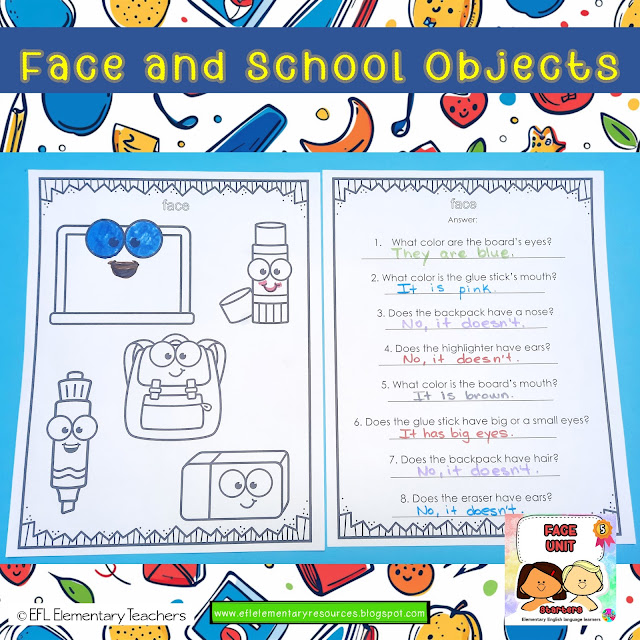This resource (Printable Counting Crayons 1-20: Numbers & Colors Games for Elementary ESL) is also included at the School Unit for Elementary ELL-Starters, at this link: https://www.teacherspayteachers.com/Product/School-Unit-for-Elementary-ELL-Starters-1707072
Counting from 1 to 20 is a key early math skill. This resource helps children practice recognizing numerals, counting crayons 1 to 20 , and connecting numbers with quantities in an engaging way. This resource connects math (counting and numbers), art (crayons and coloring), and language (speaking, listening, and writing numbers), making it a well-rounded tool for elementary classrooms.
By linking crayons to
numbers, students also strengthen their vocabulary for both numbers and colors.
Use the crayon flashcards to review the colors. Also,
review the school words using the flashcards. Ask: What’s this?
Teacher: Is this a crayon?
Students: Yes, it is.
Students identify numbers from the
flashcards displayed and choosing only 8 of them to their bingo grid,
reinforcing numeral recognition. When numbers are called out during the game,
students must listen carefully, understand, and check their grids—an excellent
listening activity for English language learners.
The finger/hand signals make simple counting an activity with movement. Students learn to count forward using the pointing finger upwards, count backward using the finger down card, and hold a number in mind by repeating it using the thumbs up card. This builds a deeper understanding of number order and sequence. Print the cards and glue onto craft sticks for easy play.
Found this game in this book and adapted
it to suit the resource: 100 games for teaching English by Agung Prihantoro.
Small
cards let students manipulate the materials directly, which
keeps them engaged and supports kinesthetic learning.
Line Up with Crayons small cards! Each student gets a small
card (number or crayon quantity). The teacher says: “Line up in order!” Students must arrange themselves in a line from
1 to 20. When everyone is in place, the class counts together from the first to
the last student.
Challenge the students to it
activity but “Backwards!” → Students line up from 20
down to 1. Another challenge is to have the students line up in “Alphabetical
order!” → Students line up in
alphabetical order of the number words (eight, five, four…).
Place the small cards in alphabetical
order.
Fold the words in each small card and
have students write the numeral and words. Place them in order.
The worksheets provide a hands-on, quiet-time opportunity for students to practice and demonstrate their understanding.
Find
and Match worksheet:
have students draw lines to match each number to the correct number word.
Missing Number and number words Fill-In. Students fill in the missing numbers.
How Many? Write the Number word. Ask students to count and write the numeral and/or number word.
 |
Listen and color worksheet. Teacher
says the number and color: “Crayon
number 5 is blue.” Students listen carefully and color
the crayon in the correct square. Continue until all 20 crayons are colored. Students
write the color word to describe each colored crayon. This activity reinforces number
recognition, listening comprehension, colors vocabulary.
This Numbers Board Game is a
fun way for students to practice counting, number recognition, and sequencing
from 1 to 20. Each player starts at one of the four starting points and takes
turns rolling a die to move along their path. The first player to reach the
center “FINISH” wins! The colorful design keeps learners engaged while
reinforcing math and language skills in an interactive way.
Say It in a Sentence: Each
time a student lands on a number, they make a sentence such as: “I see 12
crayons” or “I have 7.”
These matching mats support number
recognition, counting, and word association by giving students a physical and
visual way to match and manipulate pieces. They’re especially useful to bridge
visual and written language, reinforcing both vocabulary and concept
understanding.
There is a coloring version of the
mats. Each student gets a matching mat with crayons numbered 1 to 20 in random
order. A student spins the color spinner,
lands on a number and names it for the group find it on their mat and color it.
Continue spinning and coloring until the
mat is complete.
There is a backpack activity included in this resource: https://eflelementaryresources.blogspot.com/2025/03/backpack-school-unit-activities-for.html
Find for more ideas, tips, and free
resources for teaching English to preschool and elementary learners. Follow me on
Facebook!
👉
ESL Preschool Teachers Facebook Page
Found wonderful clipart for the numbers at Creative Fabrica. Here's my affliate link: https://www.creativefabrica.com/product/alphabet-crayon-clipart-and-number/ref/2670802/?sharedfrom=pdp


























































